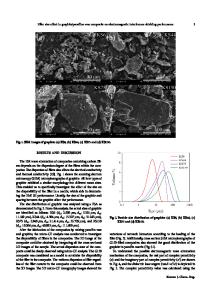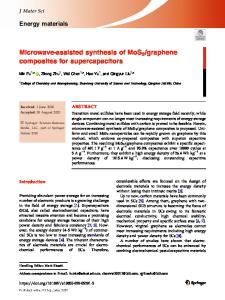High-efficiency microwave absorption and electromagnetic interference shielding of Cobalt-doped MoS 2 nanosheet anchored
- PDF / 2,546,370 Bytes
- 15 Pages / 595.276 x 790.866 pts Page_size
- 32 Downloads / 305 Views
High-efficiency microwave absorption and electromagnetic interference shielding of Cobaltdoped MoS2 nanosheet anchored on the surface reduced graphene oxide nanosheet Jagdees Prasad1, Ashwani K. Singh1, Monika Tomar2, Vinay Gupta2, and Kedar Singh1,*
1 2
School of Physical Sciences, Jawaharlal Nehru University, New Delhi 110067, India Departments of Physics and Astrophysics, Delhi University, New Delhi 110007, India
Received: 20 January 2020
ABSTRACT
Accepted: 18 September 2020
In this paper, Co-doped molybdenum disulfide anchored on the surface reduced graphene oxide (Co@MoS2/rGO) has been successfully synthesized using a simple and effective hydrothermal approach to measure their microwave shielding properties. The X-ray diffraction (XRD) technique confirmed the successful doping of magnetic atoms into the MoS2 lattice. The experiments show that 15% and 20% Co@MoS2/rGO nanocomposite have higher electromagnetic interference shielding effectiveness (EMI SE) value up to SET * 38.26 and * 46.02 dB, respectively. But pure MoS2/rGO nanocomposite demonstrates a lower EMI SE value of around * 28.90 dB over the frequency range of 8.0–12.0 GHz with a 1.7 mm thickness. A higher value of the EMI SE depends mainly on the doping percentage of Co-ion. This nanocomposite network enhances the defect dipole polarization, electric conduction, interfacial polarization, and impedance matching characteristics. It is favorable for strong attenuation and dissipation loss ability of microwave energy inside the shielding material. The actual role of Co-doping is to form a highly conductive and magnetic channel between multi-interfaces leading to enhance the migration and hopping of electrons at defective sites or interface. Therefore, the 20% Co@MoS2/rGO nanocomposite is considered as novel microwave shielding material and can be widely used in electronic information and communication devices.
Ó
Springer Science+Business
Media, LLC, part of Springer Nature 2020
Address correspondence to E-mail: [email protected]
https://doi.org/10.1007/s10854-020-04512-2
J Mater Sci: Mater Electron
1 Introduction In recent years, electronic information and communication devices have attracted widespread social and scientific attention in terms of microwave energy storage and conversion performance. These electronic devices have a potential ability for storage and transmission of information/data and can deliver us in almost no time. It plays an important role in information and communication fields through the wireless telecommunication and satellite facilities. Due to the rapid development in information and communication devices such as cellular phones, television, computers, loudspeakers, radios, and wireless wide area networks (WAN) have gained considerable attention and interest of human. It strongly influences all the aspects of daily human life and tries to make a comfortable and secure day to day life [1–3]. With the help of these electronic devices, one can easily interact and communicate with others through social network sites
Data Loading...











